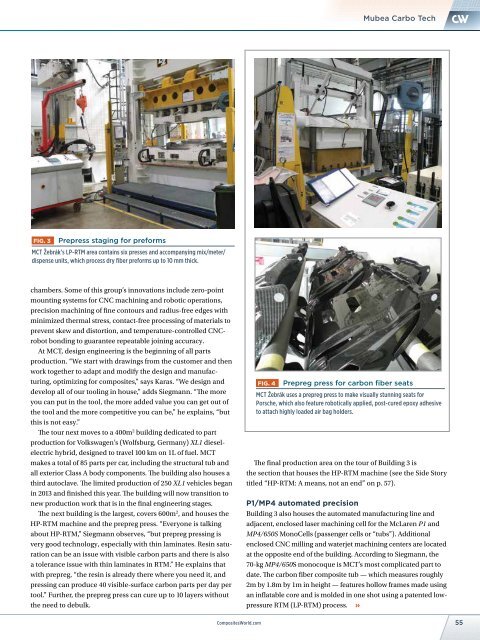FOR AUTO RTM
1VeKpGy
1VeKpGy
Create successful ePaper yourself
Turn your PDF publications into a flip-book with our unique Google optimized e-Paper software.
Mubea Carbo Tech<br />
NEWS<br />
FIG. 3 Prepress staging for preforms<br />
MCT Žebrák’s LP-<strong>RTM</strong> area contains six presses and accompanying mix/meter/<br />
dispense units, which process dry fiber preforms up to 10 mm thick.<br />
chambers. Some of this group’s innovations include zero-point<br />
mounting systems for CNC machining and robotic operations,<br />
precision machining of fine contours and radius-free edges with<br />
minimized thermal stress, contact-free processing of materials to<br />
prevent skew and distortion, and temperature-controlled CNCrobot<br />
bonding to guarantee repeatable joining accuracy.<br />
At MCT, design engineering is the beginning of all parts<br />
production. “We start with drawings from the customer and then<br />
work together to adapt and modify the design and manufacturing,<br />
optimizing for composites,” says Karas. “We design and<br />
develop all of our tooling in house,” adds Siegmann. “The more<br />
you can put in the tool, the more added value you can get out of<br />
the tool and the more competitive you can be,” he explains, “but<br />
this is not easy.”<br />
The tour next moves to a 400m 2 building dedicated to part<br />
production for Volkswagen’s (Wolfsburg, Germany) XL1 dieselelectric<br />
hybrid, designed to travel 100 km on 1L of fuel. MCT<br />
makes a total of 85 parts per car, including the structural tub and<br />
all exterior Class A body components. The building also houses a<br />
third autoclave. The limited production of 250 XL1 vehicles began<br />
in 2013 and finished this year. The building will now transition to<br />
new production work that is in the final engineering stages.<br />
The next building is the largest, covers 600m 2 , and houses the<br />
HP-<strong>RTM</strong> machine and the prepreg press. “Everyone is talking<br />
about HP-<strong>RTM</strong>,” Siegmann observes, “but prepreg pressing is<br />
very good technology, especially with thin laminates. Resin saturation<br />
can be an issue with visible carbon parts and there is also<br />
a tolerance issue with thin laminates in <strong>RTM</strong>.” He explains that<br />
with prepreg, “the resin is already there where you need it, and<br />
pressing can produce 40 visible-surface carbon parts per day per<br />
tool.” Further, the prepreg press can cure up to 10 layers without<br />
the need to debulk.<br />
FIG. 4 Prepreg press for carbon fiber seats<br />
MCT Žebrák uses a prepreg press to make visually stunning seats for<br />
Porsche, which also feature robotically applied, post-cured epoxy adhesive<br />
to attach highly loaded air bag holders.<br />
The final production area on the tour of Building 3 is<br />
the section that houses the HP-<strong>RTM</strong> machine (see the Side Story<br />
titled “HP-<strong>RTM</strong>: A means, not an end” on p. 57).<br />
P1/MP4 automated precision<br />
Building 3 also houses the automated manufacturing line and<br />
adjacent, enclosed laser machining cell for the McLaren P1 and<br />
MP4/650S MonoCells (passenger cells or “tubs”). Additional<br />
enclosed CNC milling and waterjet machining centers are located<br />
at the opposite end of the building. According to Siegmann, the<br />
70-kg MP4/650S monocoque is MCT’s most complicated part to<br />
date. The carbon fiber composite tub — which measures roughly<br />
2m by 1.8m by 1m in height — features hollow frames made using<br />
an inflatable core and is molded in one shot using a patented lowpressure<br />
<strong>RTM</strong> (LP-<strong>RTM</strong>) process.<br />
CompositesWorld.com<br />
55


